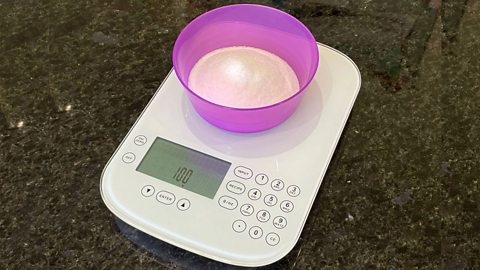Key points
- Pressure is a measure of how concentrated (or spread out) a force is.
- The amount of pressure exerted on an object depends on the force applied and the surface area it is spread over.
- We can calculate the amount of pressure on an object using a simple formula:
ĚýĚýĚýĚýĚýĚýĚýĚýĚýĚýĚýĚýĚýĚýĚýĚýĚýĚýĚýĚýĚýĚýĚýĚýĚýĚýĚýĚýĚýĚýĚýĚýĚýĚýĚýĚýĚýĚýĚýĚýĚýĚýĚýĚýĚýĚýĚýĚýĚýĚýPressure = force Ă· area
Effects of force and area on pressure
A rock resting on a soft surface, like sand or mud, will create an indentation. The depth of this indentation depends on the pressure exerted on the ground. The larger the pressureA measure of how concentrated (or spread out) a force is. Pressure is measured in pascals (Pa). the deeper the indentation it will create.
- The greater the weightA force that acts on mass, pulling it down, due to gravity. Weight is a force and forces are measured in newtons (N). of the rock, the higher the pressure it exerts on the ground.
- The smaller the surface areaThis is the total area a surface of an object occupies. Surface area is usually measured in m² or cm². resting on the ground, the higher the pressure it exerts on the ground.
We could increase the pressure even further by pressing down on the rock or standing on it, because this increases the downwards force which creates a deeper indentation.
Try it at home
Try this experiment at home to find out about pressure.
Don't forget your safety goggles!
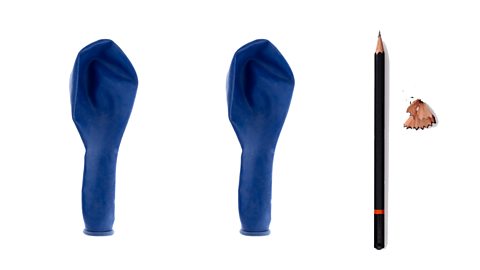
Image caption, Equipment for the pressure experiment
You will need two balloons and a pencil. Don't forget your safety goggles!
Image caption, A partially inflated balloon
Partially inflate two balloons, so they look like the balloon in the picture. Don't not blow them up all the way, they need to still be flexible.
Image caption, Equipment for the pressure experiment
Make sure that your pencil is freshly sharpened (this experiment works best with an HB pencil, or harder).
Image caption, The balloon pops easily, when you use the sharpened end of the pencil!
Place the first balloon on the table, then take the sharpened end of the pencil and push down gently on the balloon. Gradually increase the force you are pushing down with - you will find you do not need to apply much force to pop the balloon.
Image caption, The balloon does not pop easily when you use the blunt end of the pencil.
Place the second balloon on the table, then take the blunt end of the pencil (or the back of a pen) and push down gently on the balloon. Gradually increase the force you are pushing down with – you will find it takes a lot more force to pop the balloon, or it may not pop at all.
Image caption, Why?
The blunt end of the pencil has a much larger surface area than the sharpened end, so it takes a lot more force to exert the same pressure. This is why the balloon does not pop as easily.
1 of 6
Calculating pressure
Pressure can be measured in many different units, but scientists usually use units called pascals (Pa)The units used to measure pressure, represented using the letters Pa. A pressure of one pascal is the same as a force of 1 newton spread over a surface area of 1 square metre..
Other units commonly used to measure pressure include newtons per square centimetre (±·/ł¦łľÂ˛),barA unit of pressure often used to express water pressures and air pressures. One bar is the same as 100,000 Pa (100 kPa) and is very close to the pressure the Earth’s atmosphere exerts on a person when they are at ground level. and pounds per square inch (P.S.I.)
One pascal is the pressure exerted when a force of one newton is spread over an area of 1 square metre, so one pascal (1 Pa) is the same as one newton per square metre (1 N/m²).
Most physicists use pascals or ±·/ł¦łľÂ˛ when carrying out pressure calculations, and these are the units that should be used for physics calculations.
We can calculate the amount of pressure on an object using a simple formula:
ĚýĚýĚýĚýĚýĚýĚýĚýĚýĚýĚýĚýĚýĚýĚýĚýĚýĚýĚýĚýĚýĚýĚýĚýĚýĚýĚýĚýĚýĚýĚýĚýĚýĚýĚýĚýĚýĚýĚýĚýĚýĚýĚýĚýĚýĚýPressure = force Ă· area
Example
Consider the example of the balloon being popped using the blunt end of a pencil. If the area of the end of the pencil is 0.5cm² and the force required to pop the balloon is 50 newtons, then we can calculate the pressure as follows:
\(Pressure = force Ă· area \)
\(Pressure = 50 N ÷ 0.5 cm² \)
\(Pressure = 100 ±·/ł¦łľÂ˛ \)
When the balloon was popped using the sharp end of a pencil, which has a much smaller surface area (only 0.001cm²), the force required to pop the balloon was much lower (0.1 newtons).
\(Pressure = force Ă· area \)
\(Pressure = 0.1 N ÷ 0.001 cm² \)
\(Pressure = 100 ±·/ł¦łľÂ˛ \)
This is why the balloon popped more easily – the pressure required to pop the balloon is the same as before, but the force needed was much lower. A smaller force exerted the same pressure, because the area over which it was spread (the sharpened end of the pencil) was much lower.
It would be even more difficult to pop the balloon if you pressed down with the palm of your hand, which has a much larger surface area.
Assuming the pressure required to pop the balloon is the same 100±·/ł¦łľÂ˛ and the area of your palm is 100cm², calculate the force required to pop the balloon.
\(Force = pressure \times area \)
\(Force = 100 ±·/ł¦łľÂ˛ \times 100 cm² \)
\(Force = 10,000 N \)
The force required to pop the balloon with the palm of your hand is 10,000N.
Applications of pressure
Understanding the connection between force, pressure and area can help scientists and engineers design and make more effective machines and devices.
For example, knives and cutting tools like axes have a small surface area, so they exert the largest possible pressure and cut things more easily. These tools often become blunt because the surface area of the cutting edge increases after repeated uses. Sharpening these tools ensures the surface area remains small, so the tools exert a larger pressure and will cut more effectively.
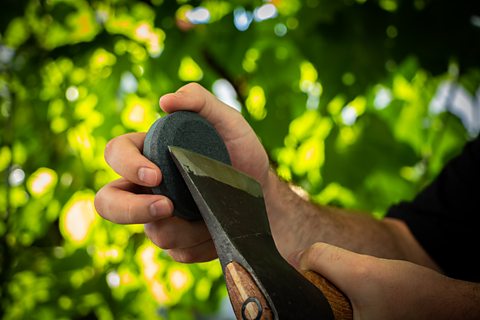
The opposite principle is used for designing skis and snowboards – these have a large surface area, to stop them from sinking into the snow.
The large surface area spreads the snowboarder’s weight out, reducing the pressure exerted on the snow. This stops them from sinking, even if the snow is very deep.
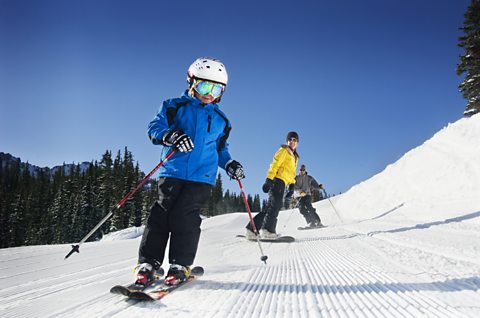
What would the pressure exerted in the snow of a skier be, if the person on the skis weighed 700 newtons and the skis had a surface area of 1.4m²?
\(Pressure = force Ă· area \)
\(Pressure = 700 N ÷ 1.4 m² \)
\(Pressure = 500 N/m² \)
The pressure exerted on the snow would be 500 N/m².
Understanding pressure is useful in designing effective brakes for bicycles and cars, hydraulic suspension systems, diving equipment, submarines, spacecraft and much more. High pressure jets of water can be used for cleaning and even to cut through metal.
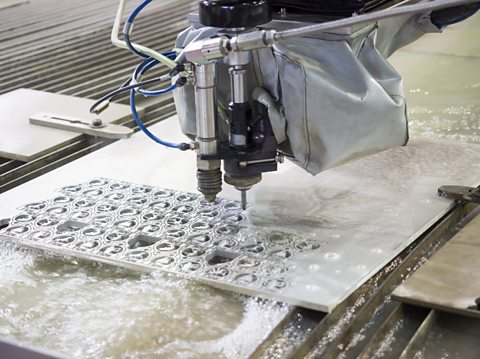
Test your knowledge
Teaching resources
Are you a teacher looking for more resources? This series of short explainer films with Professor Brian Cox focuses on forces, speed and motion. Each clip uses simple terms and concrete examples to explain deep concepts.
Â鶹ԼĹÄ Teach has thousands of free, curriculum-linked resources to help deliver lessons - all arranged by subject and age group.
Play the Atomic Labs game! gamePlay the Atomic Labs game!
Try out practical experiments in this KS3 science game.

More on Forces and movement
Find out more by working through a topic
- count3 of 16

- count4 of 16

- count5 of 16
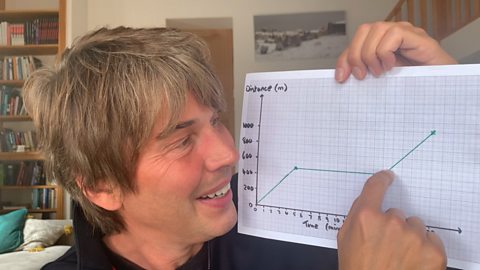
- count6 of 16
